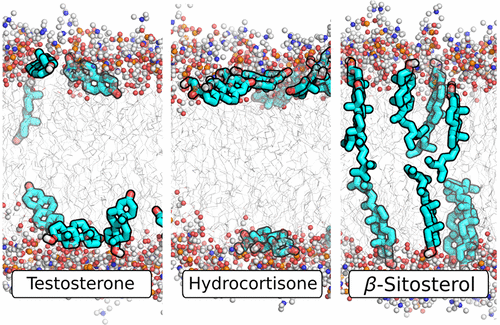当前位置:
X-MOL 学术
›
ACS Cent. Sci.
›
论文详情
Our official English website, www.x-mol.net, welcomes your feedback! (Note: you will need to create a separate account there.)
Rationalizing Steroid Interactions with Lipid Membranes: Conformations, Partitioning, and Kinetics
ACS Central Science ( IF 18.2 ) Pub Date : 2018-08-14 00:00:00 , DOI: 10.1021/acscentsci.8b00332 Kalina Atkovska 1 , Johannes Klingler 2 , Johannes Oberwinkler 3 , Sandro Keller 2 , Jochen S. Hub 1, 4
ACS Central Science ( IF 18.2 ) Pub Date : 2018-08-14 00:00:00 , DOI: 10.1021/acscentsci.8b00332 Kalina Atkovska 1 , Johannes Klingler 2 , Johannes Oberwinkler 3 , Sandro Keller 2 , Jochen S. Hub 1, 4
Affiliation

|
Steroids have numerous physiological functions associated with cellular signaling or modulation of the lipid membrane structure and dynamics, and as such, they have found broad pharmacological applications. Steroid–membrane interactions are relevant to multiple steps of steroid biosynthesis and action, as steroids are known to interact with neurotransmitter or membrane steroid receptors, and steroids must cross lipid membranes to exert their physiological functions. Therefore, rationalizing steroid function requires understanding of steroid–membrane interactions. We combined molecular dynamics simulations and isothermal titration calorimetry to characterize the conformations and the energetics of partitioning, in addition to the kinetics of flip–flop transitions and membrane exit, of 26 representative steroid compounds in a model lipid membrane. The steroid classes covered in this study include birth control and anabolic drugs, sex and corticosteroid hormones, neuroactive steroids, as well as steroids modulating the lipid membrane structure. We found that the conformational ensembles adopted by different steroids vary greatly, as quantified by their distributions of tilt angles and insertion depths into the membrane, ranging from well-defined steroid conformations with orientations either parallel or normal to the membrane, to wide conformational distributions. Surprisingly, despite their chemical diversity, the membrane/water partition coefficient is similar among most steroids, except for structural steroids such as cholesterol, leading to similar rates for exiting the membrane. By contrast, the rates of steroid flip–flop vary by at least 9 orders of magnitude, revealing that flip–flop is the rate-limiting step during cellular uptake of polar steroids. This study lays the ground for a quantitative understanding of steroid–membrane interactions, and it will hence be of use for studies of steroid biosynthesis and function as well as for the development and usage of steroids in a pharmacological context.
中文翻译:

与脂质膜的类固醇相互作用合理化:构象,分配和动力学
类固醇具有与细胞信号传导或脂质膜结构和动力学调节相关的许多生理功能,因此,它们已发现了广泛的药理应用。类固醇膜的相互作用与类固醇生物合成和作用的多个步骤有关,因为已知类固醇会与神经递质或膜类固醇受体相互作用,并且类固醇必须穿过脂质膜才能发挥其生理功能。因此,合理化类固醇功能需要了解类固醇与膜之间的相互作用。我们结合了分子动力学模拟和等温滴定量热法,以表征脂膜模型中26种代表性类固醇化合物的构象和分配能,以及触发器转变和膜出口的动力学。这项研究涵盖的类固醇类别包括节育和合成代谢药物,性激素和皮质类固醇激素,神经活性类固醇以及调节脂质膜结构的类固醇。我们发现,不同的类固醇所采用的构象集合变化很大,如通过其倾斜角和向膜中插入深度的分布所量化的,范围从定义明确的类固醇构象(平行或垂直于膜的方向)到较宽的构象分布。出乎意料的是,尽管它们的化学多样性,但大多数类固醇之间的膜/水分配系数相似,除了胆固醇等结构性类固醇外,导致离开膜的速率相似。相比之下,类固醇触发器的速率至少相差9个数量级,揭示了触发器是极性类固醇细胞摄取过程中的限速步骤。这项研究为定量了解类固醇-膜相互作用奠定了基础,因此将用于类固醇的生物合成和功能研究,以及在药理学背景下类固醇的开发和使用。
更新日期:2018-08-14
中文翻译:

与脂质膜的类固醇相互作用合理化:构象,分配和动力学
类固醇具有与细胞信号传导或脂质膜结构和动力学调节相关的许多生理功能,因此,它们已发现了广泛的药理应用。类固醇膜的相互作用与类固醇生物合成和作用的多个步骤有关,因为已知类固醇会与神经递质或膜类固醇受体相互作用,并且类固醇必须穿过脂质膜才能发挥其生理功能。因此,合理化类固醇功能需要了解类固醇与膜之间的相互作用。我们结合了分子动力学模拟和等温滴定量热法,以表征脂膜模型中26种代表性类固醇化合物的构象和分配能,以及触发器转变和膜出口的动力学。这项研究涵盖的类固醇类别包括节育和合成代谢药物,性激素和皮质类固醇激素,神经活性类固醇以及调节脂质膜结构的类固醇。我们发现,不同的类固醇所采用的构象集合变化很大,如通过其倾斜角和向膜中插入深度的分布所量化的,范围从定义明确的类固醇构象(平行或垂直于膜的方向)到较宽的构象分布。出乎意料的是,尽管它们的化学多样性,但大多数类固醇之间的膜/水分配系数相似,除了胆固醇等结构性类固醇外,导致离开膜的速率相似。相比之下,类固醇触发器的速率至少相差9个数量级,揭示了触发器是极性类固醇细胞摄取过程中的限速步骤。这项研究为定量了解类固醇-膜相互作用奠定了基础,因此将用于类固醇的生物合成和功能研究,以及在药理学背景下类固醇的开发和使用。



























 京公网安备 11010802027423号
京公网安备 11010802027423号